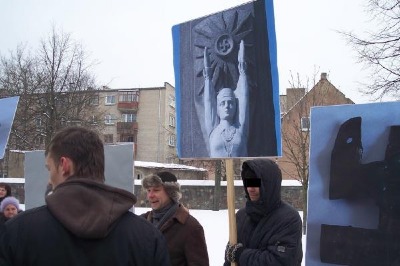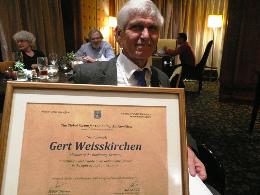The following is the text of an email sent by Sir Martin Gilbert to an official of Lithuania’s Jewish state museum in defense of Rachel Kostanian, the internationally acclaimed cofounder and longtime director of the Holocaust section of the state Jewish museum, long known as “The Green House” (it is housed in a green wooden house at Pamenkalnio 12, invisible from the street, and up a steep driveway). She is also an eminent author, creator of exhibits and catalogues, and Holocaust educator who has engated with thousands of loval and foreign visitors to the museum. At Sir Martin’s request, the name of the recipient, and of others mentioned in the letter, have been redacted to maintain confidences and avert unnecessary embarrassments. The alleged “mistake” referred to in the final paragraph refers to a powerful new Holocaust documentary film directed by Saulius Beržinis, which Rachel Kostanian enabled, helped to research and complete, and obtained the funding for from a prominent Litvak family in the United Kingdom. The film was apparently deemed unacceptable for its “excessive truth telling,” as one (non-Jewish) museum worker, speaking off the record, put it with some irony. It will presumably one day find its way to the public square one way or another.
Sir Martin Gilbert’s foreword to Rachel Kostanian’s book Spiritual Resistance in the Vilna Ghetto
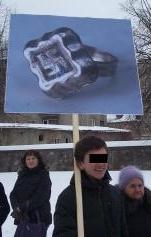 A Lithuanian court in Klaipeda approved the public display of swastikas on the grounds that they are ‘Lithuania’s historical heritage rather than symbols of Nazi Germany’. An ultranationalist ‘expert’ transported from Vilnius was easily able to persuade the court, which did not bother to ask a contrasting view of the Holocaust Survivor community, or the Jewish Community of Lithuania, in a European country with one of the highest proportions of Holocaust genocide on the continent. This sad distinction resulted from
A Lithuanian court in Klaipeda approved the public display of swastikas on the grounds that they are ‘Lithuania’s historical heritage rather than symbols of Nazi Germany’. An ultranationalist ‘expert’ transported from Vilnius was easily able to persuade the court, which did not bother to ask a contrasting view of the Holocaust Survivor community, or the Jewish Community of Lithuania, in a European country with one of the highest proportions of Holocaust genocide on the continent. This sad distinction resulted from 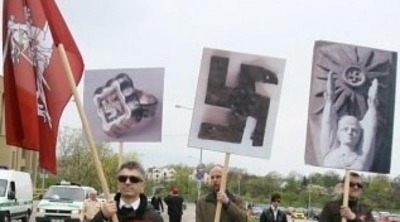 A Lithuanian court in Klaipeda approved the public display of swastikas on the grounds that they are ‘Lithuania’s historical heritage rather than symbols of Nazi Germany’. An ‘expert’ transported from Vilnius was easily able to persuade the court, which did not bother to ask a contrasting view of the Holocaust Survivor community, or the Jewish Community of Lithuania, in a European country with the highest proportion of Holocaust genocide on the continent. This sad distinction resulted from
A Lithuanian court in Klaipeda approved the public display of swastikas on the grounds that they are ‘Lithuania’s historical heritage rather than symbols of Nazi Germany’. An ‘expert’ transported from Vilnius was easily able to persuade the court, which did not bother to ask a contrasting view of the Holocaust Survivor community, or the Jewish Community of Lithuania, in a European country with the highest proportion of Holocaust genocide on the continent. This sad distinction resulted from 
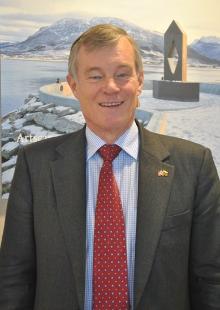 Norway’s ambassador to Lithuania HE Steinar Gil has emerged as a Baltic region champion of human rights, at a time when the Lithuanian government continues its gestures of support for the March 11th neo-Nazi marchers (parallel to Latvian leaders’ stout defense of the March 16th Waffen SS march in Riga). Speaking at a March 19th forum on ‘European and Lithuanian Values’ at the Lithuanian parliament, Ambassador Gil remarked for the record: ‘Every foreigner in Lithuania noticed this march, where the participants were shouting “Lithuania for Lithuanians”. We were shocked.’ The ambassador also pointed out politely that fifty parliamentarians had signed a petition to ban the Baltic Pride gay-rights parade. He asked: How many had spoken up against the nationalist march? He added that every person with respect for herself or himself and for her or his country should condemn this kind of manifestation. Others who have spoken up include Irish ambassador HE Dónal Denham; UK ambassador HE Simon Butt; and Lithuania’s sole Liberal member of the European Parliament, Prof. Leonidas Donskis.
Norway’s ambassador to Lithuania HE Steinar Gil has emerged as a Baltic region champion of human rights, at a time when the Lithuanian government continues its gestures of support for the March 11th neo-Nazi marchers (parallel to Latvian leaders’ stout defense of the March 16th Waffen SS march in Riga). Speaking at a March 19th forum on ‘European and Lithuanian Values’ at the Lithuanian parliament, Ambassador Gil remarked for the record: ‘Every foreigner in Lithuania noticed this march, where the participants were shouting “Lithuania for Lithuanians”. We were shocked.’ The ambassador also pointed out politely that fifty parliamentarians had signed a petition to ban the Baltic Pride gay-rights parade. He asked: How many had spoken up against the nationalist march? He added that every person with respect for herself or himself and for her or his country should condemn this kind of manifestation. Others who have spoken up include Irish ambassador HE Dónal Denham; UK ambassador HE Simon Butt; and Lithuania’s sole Liberal member of the European Parliament, Prof. Leonidas Donskis.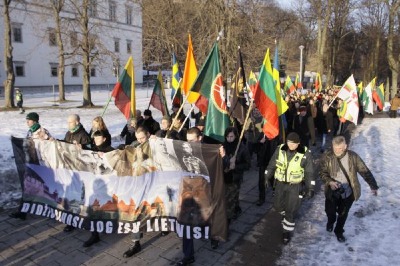
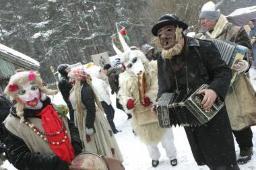 The annual Uzgavenes festival, celebrated throughout Lithuania, again featured costumes and behavior making fun of – and perpetuating the worst stereotypes of – Roma and Jews (‘and monsters’). Roma and Jews comprise two of the country’s smallest and weakest minorities. Most of both communities were murdered during the Holocaust by the Nazis (with massive voluntary participation in the killings by locals). Today, progressive forces continue to live in hope that political, academic, legal, religious and cultural opinion makers in the country will rise to the occasion of explaining the essence, evil and dangers of such rampant racism unconvincingly disguised as the majority’s ‘national ethnographic tradition’. See below at 2008 (→ 6 Feb) for
The annual Uzgavenes festival, celebrated throughout Lithuania, again featured costumes and behavior making fun of – and perpetuating the worst stereotypes of – Roma and Jews (‘and monsters’). Roma and Jews comprise two of the country’s smallest and weakest minorities. Most of both communities were murdered during the Holocaust by the Nazis (with massive voluntary participation in the killings by locals). Today, progressive forces continue to live in hope that political, academic, legal, religious and cultural opinion makers in the country will rise to the occasion of explaining the essence, evil and dangers of such rampant racism unconvincingly disguised as the majority’s ‘national ethnographic tradition’. See below at 2008 (→ 6 Feb) for 